HPE Report: Evaluating Touch Football Training Program Effectiveness
VerifiedAdded on 2020/06/06
|8
|1555
|85
Report
AI Summary
This report analyzes a touch football training program, focusing on the development of individual and team performance. It explores the importance of fitness components such as speed, strength, and aerobic endurance, and their relationship with energy systems. The report evaluates the appropriateness and effectiveness of isotonic and Fartlek training methods for touch football players. It discusses the benefits of each method, considering factors like muscle contraction and continuous training, while also acknowledging potential drawbacks. The report also emphasizes the importance of exercise physiology principles and offers recommendations for enhancing the training program's effectiveness, including the need for player coordination and the use of various tools to regain energy. The report concludes by suggesting ways to improve future training sessions, highlighting the significance of aerobic systems and the importance of incorporating diverse physical activities to maximize player development.
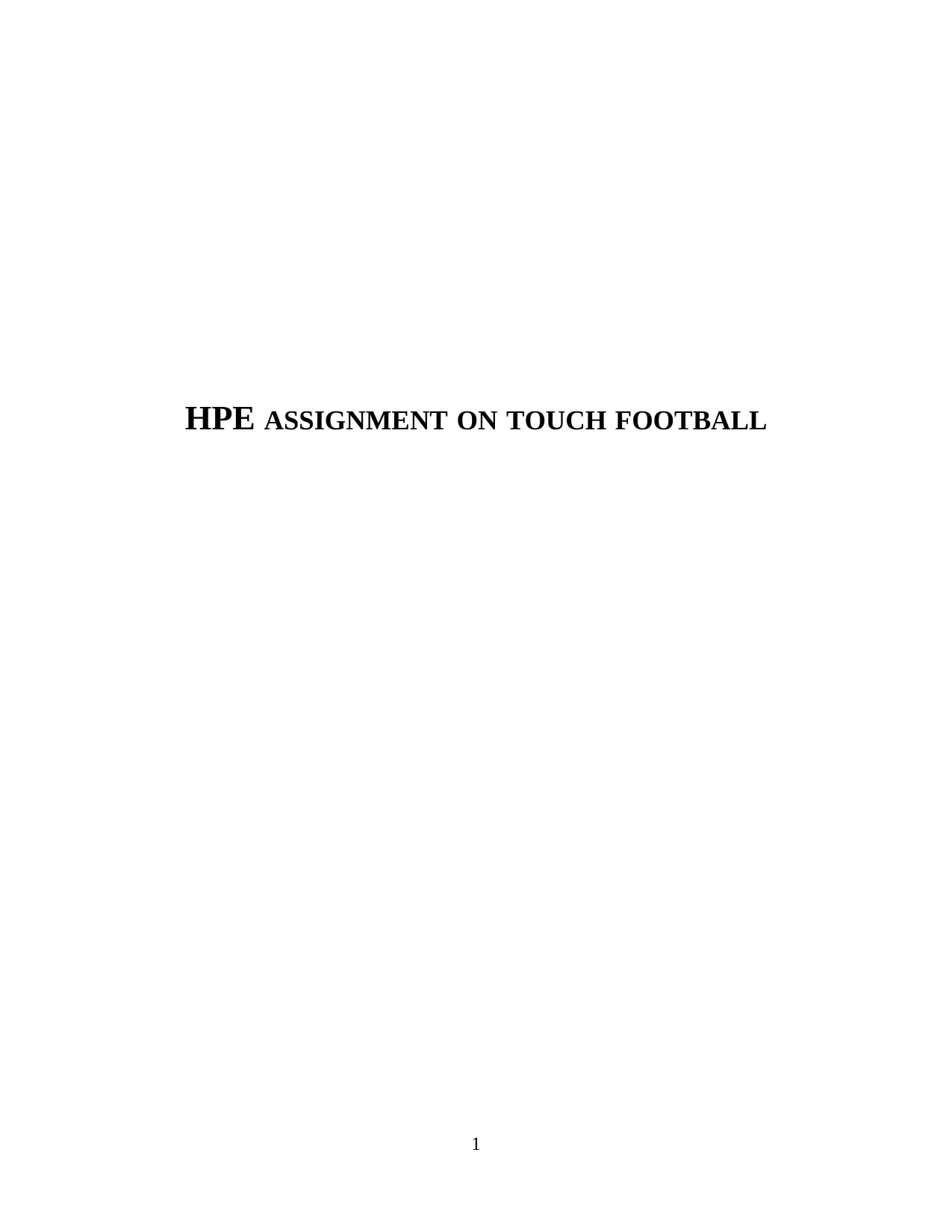
HPE ASSIGNMENT ON TOUCH FOOTBALL
1
1
Paraphrase This Document
Need a fresh take? Get an instant paraphrase of this document with our AI Paraphraser
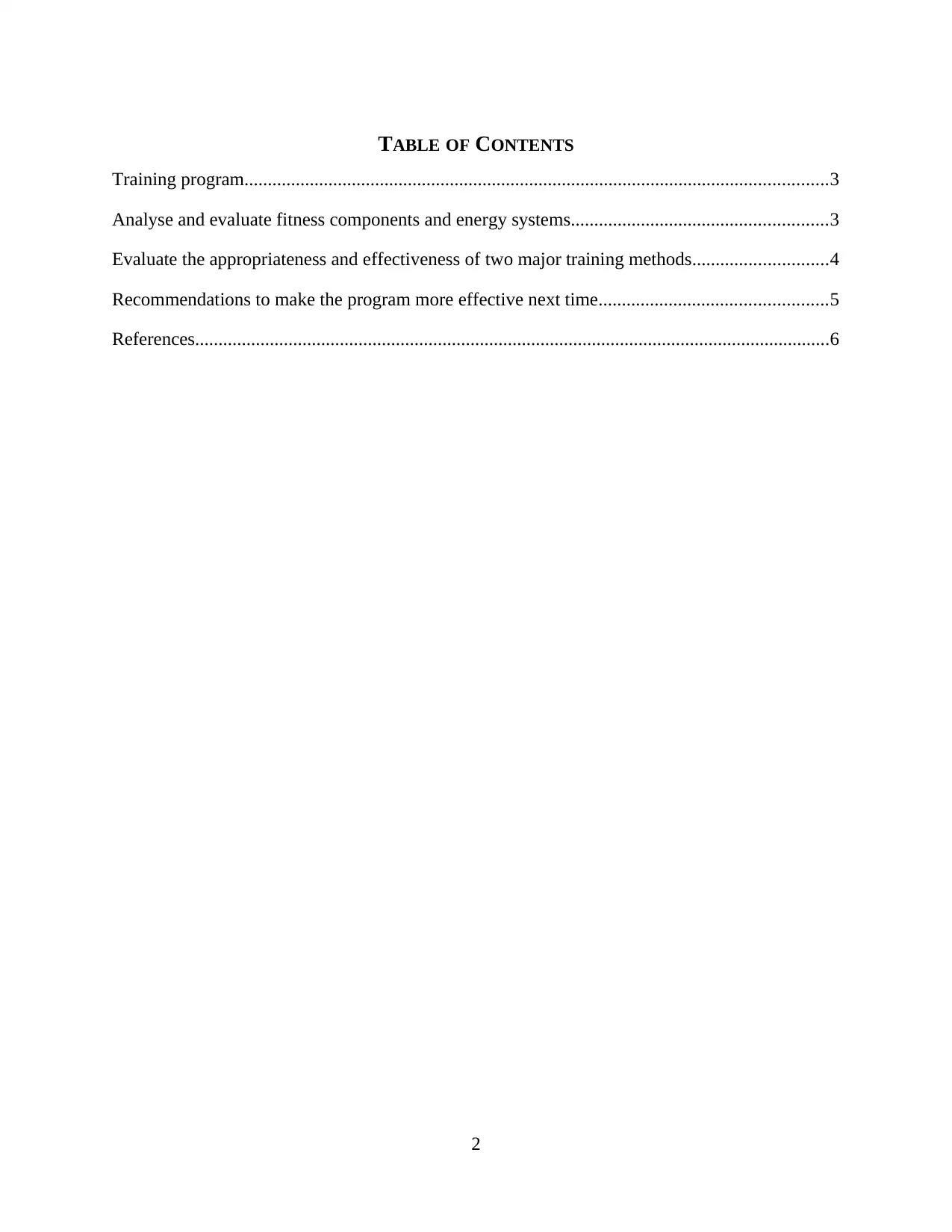
TABLE OF CONTENTS
Training program.............................................................................................................................3
Analyse and evaluate fitness components and energy systems.......................................................3
Evaluate the appropriateness and effectiveness of two major training methods.............................4
Recommendations to make the program more effective next time.................................................5
References........................................................................................................................................6
2
Training program.............................................................................................................................3
Analyse and evaluate fitness components and energy systems.......................................................3
Evaluate the appropriateness and effectiveness of two major training methods.............................4
Recommendations to make the program more effective next time.................................................5
References........................................................................................................................................6
2
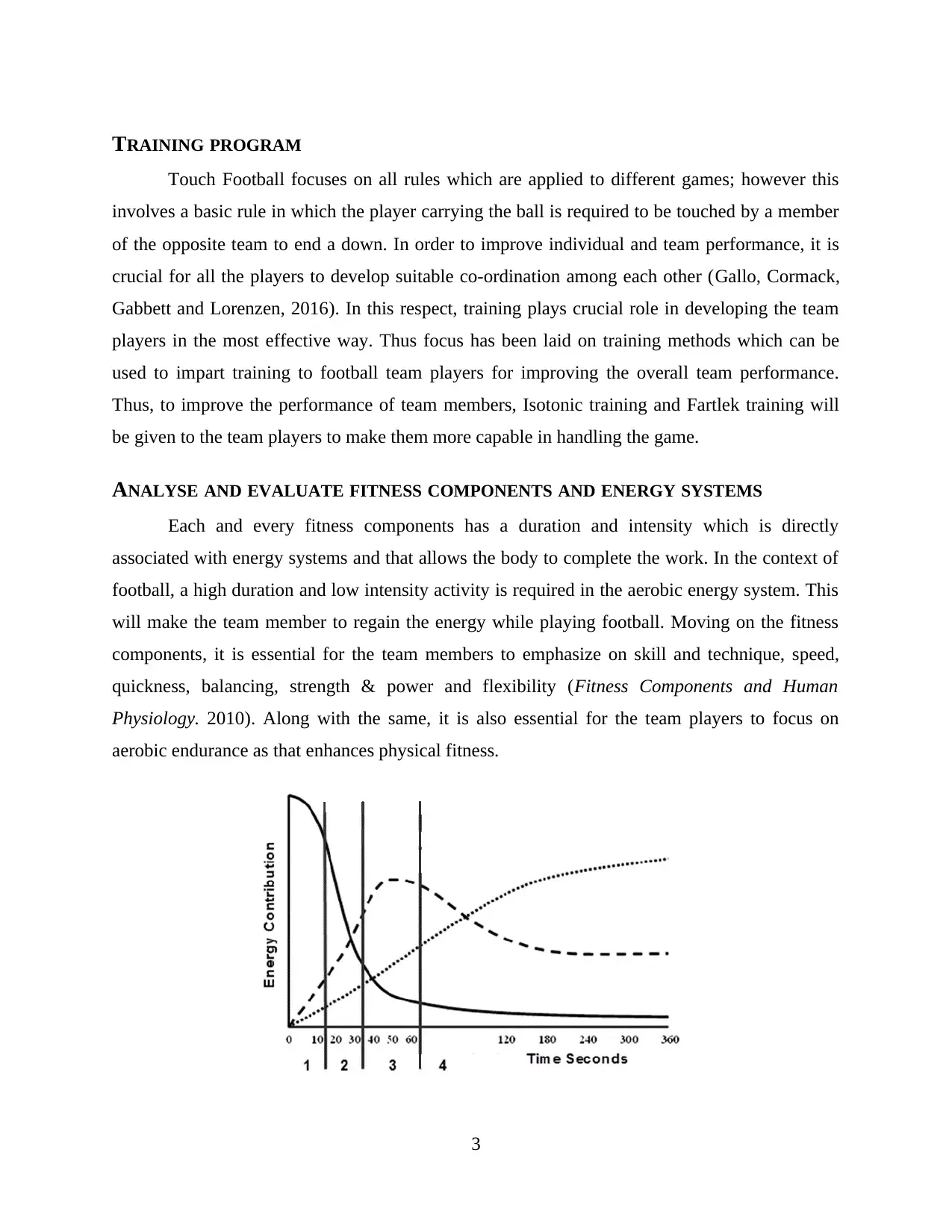
TRAINING PROGRAM
Touch Football focuses on all rules which are applied to different games; however this
involves a basic rule in which the player carrying the ball is required to be touched by a member
of the opposite team to end a down. In order to improve individual and team performance, it is
crucial for all the players to develop suitable co-ordination among each other (Gallo, Cormack,
Gabbett and Lorenzen, 2016). In this respect, training plays crucial role in developing the team
players in the most effective way. Thus focus has been laid on training methods which can be
used to impart training to football team players for improving the overall team performance.
Thus, to improve the performance of team members, Isotonic training and Fartlek training will
be given to the team players to make them more capable in handling the game.
ANALYSE AND EVALUATE FITNESS COMPONENTS AND ENERGY SYSTEMS
Each and every fitness components has a duration and intensity which is directly
associated with energy systems and that allows the body to complete the work. In the context of
football, a high duration and low intensity activity is required in the aerobic energy system. This
will make the team member to regain the energy while playing football. Moving on the fitness
components, it is essential for the team members to emphasize on skill and technique, speed,
quickness, balancing, strength & power and flexibility (Fitness Components and Human
Physiology. 2010). Along with the same, it is also essential for the team players to focus on
aerobic endurance as that enhances physical fitness.
3
Touch Football focuses on all rules which are applied to different games; however this
involves a basic rule in which the player carrying the ball is required to be touched by a member
of the opposite team to end a down. In order to improve individual and team performance, it is
crucial for all the players to develop suitable co-ordination among each other (Gallo, Cormack,
Gabbett and Lorenzen, 2016). In this respect, training plays crucial role in developing the team
players in the most effective way. Thus focus has been laid on training methods which can be
used to impart training to football team players for improving the overall team performance.
Thus, to improve the performance of team members, Isotonic training and Fartlek training will
be given to the team players to make them more capable in handling the game.
ANALYSE AND EVALUATE FITNESS COMPONENTS AND ENERGY SYSTEMS
Each and every fitness components has a duration and intensity which is directly
associated with energy systems and that allows the body to complete the work. In the context of
football, a high duration and low intensity activity is required in the aerobic energy system. This
will make the team member to regain the energy while playing football. Moving on the fitness
components, it is essential for the team members to emphasize on skill and technique, speed,
quickness, balancing, strength & power and flexibility (Fitness Components and Human
Physiology. 2010). Along with the same, it is also essential for the team players to focus on
aerobic endurance as that enhances physical fitness.
3
⊘ This is a preview!⊘
Do you want full access?
Subscribe today to unlock all pages.

Trusted by 1+ million students worldwide
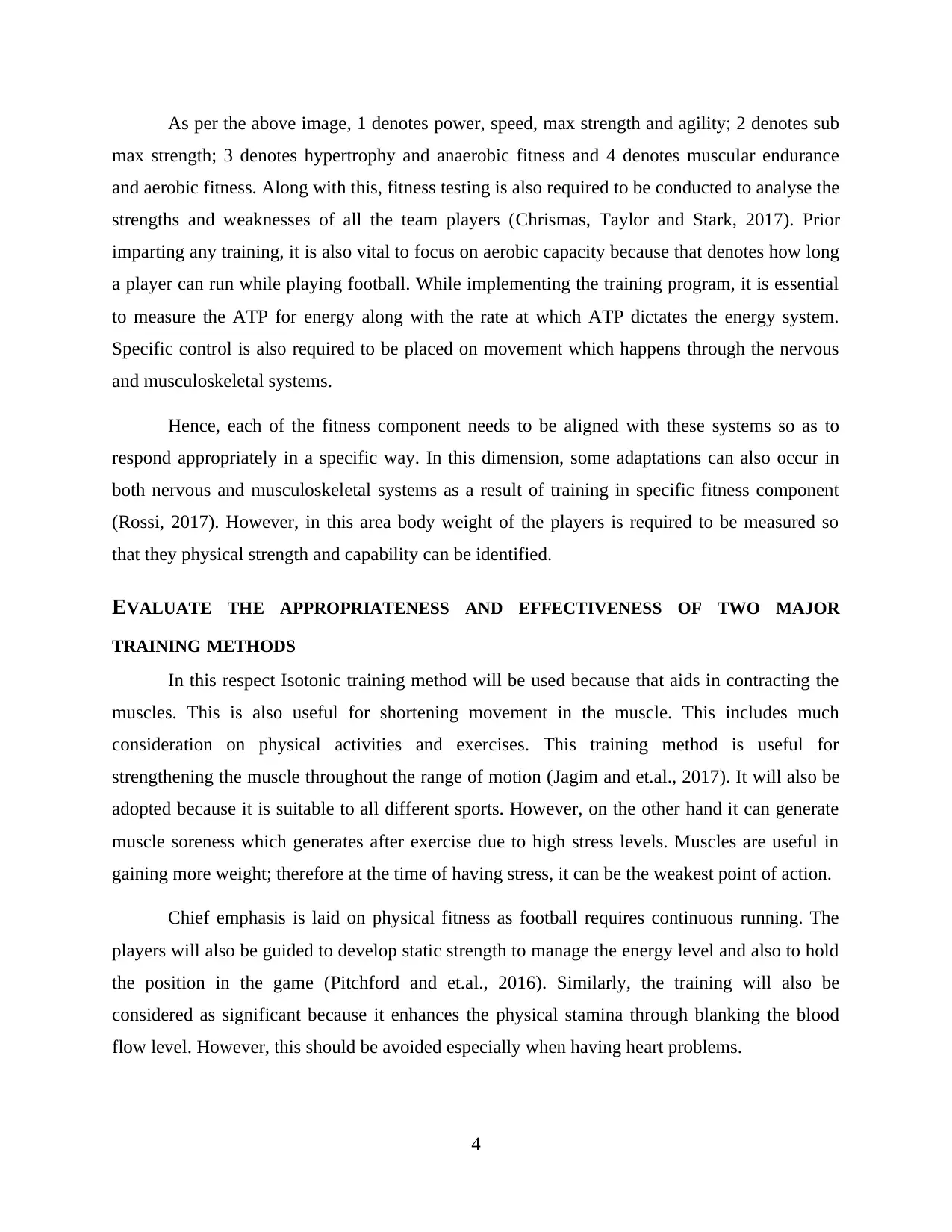
As per the above image, 1 denotes power, speed, max strength and agility; 2 denotes sub
max strength; 3 denotes hypertrophy and anaerobic fitness and 4 denotes muscular endurance
and aerobic fitness. Along with this, fitness testing is also required to be conducted to analyse the
strengths and weaknesses of all the team players (Chrismas, Taylor and Stark, 2017). Prior
imparting any training, it is also vital to focus on aerobic capacity because that denotes how long
a player can run while playing football. While implementing the training program, it is essential
to measure the ATP for energy along with the rate at which ATP dictates the energy system.
Specific control is also required to be placed on movement which happens through the nervous
and musculoskeletal systems.
Hence, each of the fitness component needs to be aligned with these systems so as to
respond appropriately in a specific way. In this dimension, some adaptations can also occur in
both nervous and musculoskeletal systems as a result of training in specific fitness component
(Rossi, 2017). However, in this area body weight of the players is required to be measured so
that they physical strength and capability can be identified.
EVALUATE THE APPROPRIATENESS AND EFFECTIVENESS OF TWO MAJOR
TRAINING METHODS
In this respect Isotonic training method will be used because that aids in contracting the
muscles. This is also useful for shortening movement in the muscle. This includes much
consideration on physical activities and exercises. This training method is useful for
strengthening the muscle throughout the range of motion (Jagim and et.al., 2017). It will also be
adopted because it is suitable to all different sports. However, on the other hand it can generate
muscle soreness which generates after exercise due to high stress levels. Muscles are useful in
gaining more weight; therefore at the time of having stress, it can be the weakest point of action.
Chief emphasis is laid on physical fitness as football requires continuous running. The
players will also be guided to develop static strength to manage the energy level and also to hold
the position in the game (Pitchford and et.al., 2016). Similarly, the training will also be
considered as significant because it enhances the physical stamina through blanking the blood
flow level. However, this should be avoided especially when having heart problems.
4
max strength; 3 denotes hypertrophy and anaerobic fitness and 4 denotes muscular endurance
and aerobic fitness. Along with this, fitness testing is also required to be conducted to analyse the
strengths and weaknesses of all the team players (Chrismas, Taylor and Stark, 2017). Prior
imparting any training, it is also vital to focus on aerobic capacity because that denotes how long
a player can run while playing football. While implementing the training program, it is essential
to measure the ATP for energy along with the rate at which ATP dictates the energy system.
Specific control is also required to be placed on movement which happens through the nervous
and musculoskeletal systems.
Hence, each of the fitness component needs to be aligned with these systems so as to
respond appropriately in a specific way. In this dimension, some adaptations can also occur in
both nervous and musculoskeletal systems as a result of training in specific fitness component
(Rossi, 2017). However, in this area body weight of the players is required to be measured so
that they physical strength and capability can be identified.
EVALUATE THE APPROPRIATENESS AND EFFECTIVENESS OF TWO MAJOR
TRAINING METHODS
In this respect Isotonic training method will be used because that aids in contracting the
muscles. This is also useful for shortening movement in the muscle. This includes much
consideration on physical activities and exercises. This training method is useful for
strengthening the muscle throughout the range of motion (Jagim and et.al., 2017). It will also be
adopted because it is suitable to all different sports. However, on the other hand it can generate
muscle soreness which generates after exercise due to high stress levels. Muscles are useful in
gaining more weight; therefore at the time of having stress, it can be the weakest point of action.
Chief emphasis is laid on physical fitness as football requires continuous running. The
players will also be guided to develop static strength to manage the energy level and also to hold
the position in the game (Pitchford and et.al., 2016). Similarly, the training will also be
considered as significant because it enhances the physical stamina through blanking the blood
flow level. However, this should be avoided especially when having heart problems.
4
Paraphrase This Document
Need a fresh take? Get an instant paraphrase of this document with our AI Paraphraser
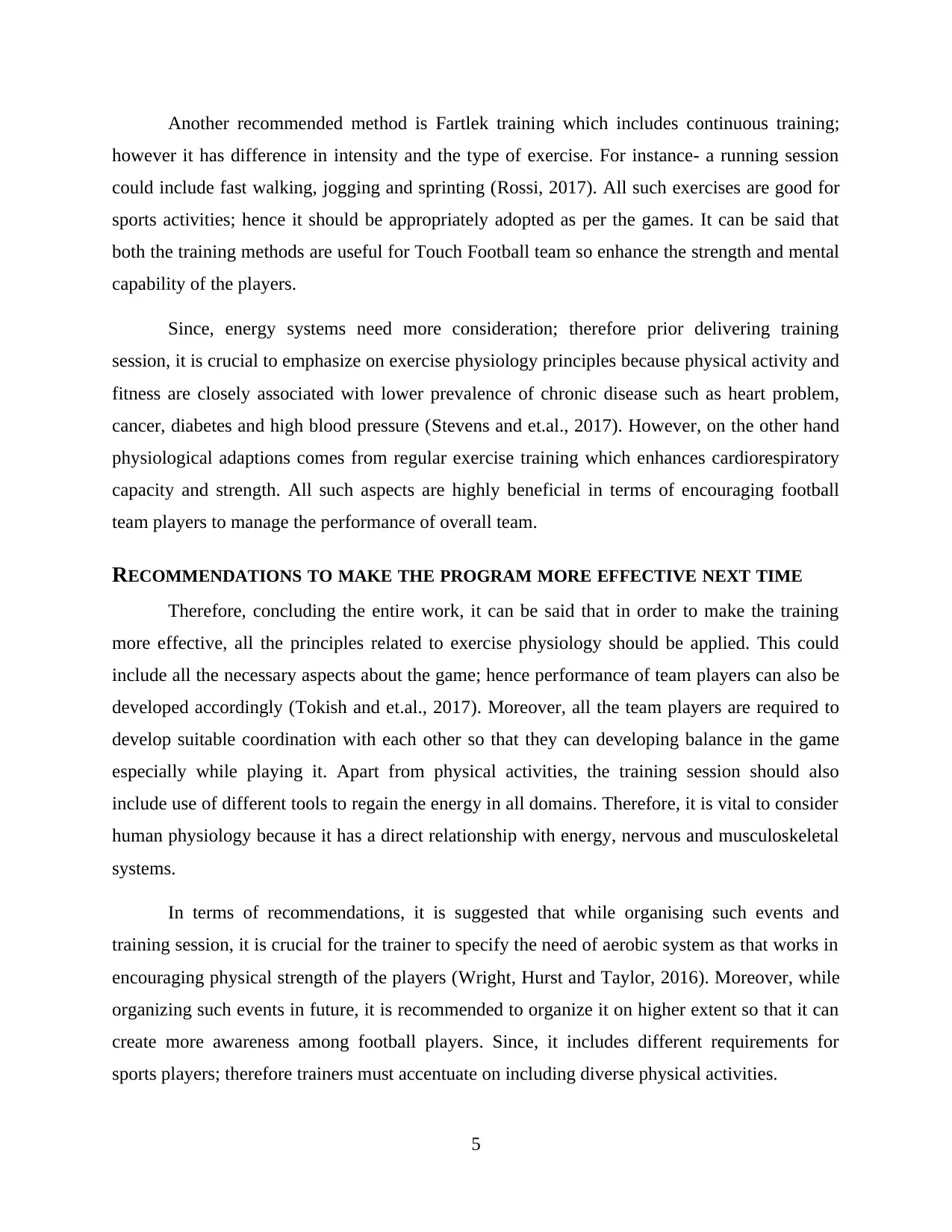
Another recommended method is Fartlek training which includes continuous training;
however it has difference in intensity and the type of exercise. For instance- a running session
could include fast walking, jogging and sprinting (Rossi, 2017). All such exercises are good for
sports activities; hence it should be appropriately adopted as per the games. It can be said that
both the training methods are useful for Touch Football team so enhance the strength and mental
capability of the players.
Since, energy systems need more consideration; therefore prior delivering training
session, it is crucial to emphasize on exercise physiology principles because physical activity and
fitness are closely associated with lower prevalence of chronic disease such as heart problem,
cancer, diabetes and high blood pressure (Stevens and et.al., 2017). However, on the other hand
physiological adaptions comes from regular exercise training which enhances cardiorespiratory
capacity and strength. All such aspects are highly beneficial in terms of encouraging football
team players to manage the performance of overall team.
RECOMMENDATIONS TO MAKE THE PROGRAM MORE EFFECTIVE NEXT TIME
Therefore, concluding the entire work, it can be said that in order to make the training
more effective, all the principles related to exercise physiology should be applied. This could
include all the necessary aspects about the game; hence performance of team players can also be
developed accordingly (Tokish and et.al., 2017). Moreover, all the team players are required to
develop suitable coordination with each other so that they can developing balance in the game
especially while playing it. Apart from physical activities, the training session should also
include use of different tools to regain the energy in all domains. Therefore, it is vital to consider
human physiology because it has a direct relationship with energy, nervous and musculoskeletal
systems.
In terms of recommendations, it is suggested that while organising such events and
training session, it is crucial for the trainer to specify the need of aerobic system as that works in
encouraging physical strength of the players (Wright, Hurst and Taylor, 2016). Moreover, while
organizing such events in future, it is recommended to organize it on higher extent so that it can
create more awareness among football players. Since, it includes different requirements for
sports players; therefore trainers must accentuate on including diverse physical activities.
5
however it has difference in intensity and the type of exercise. For instance- a running session
could include fast walking, jogging and sprinting (Rossi, 2017). All such exercises are good for
sports activities; hence it should be appropriately adopted as per the games. It can be said that
both the training methods are useful for Touch Football team so enhance the strength and mental
capability of the players.
Since, energy systems need more consideration; therefore prior delivering training
session, it is crucial to emphasize on exercise physiology principles because physical activity and
fitness are closely associated with lower prevalence of chronic disease such as heart problem,
cancer, diabetes and high blood pressure (Stevens and et.al., 2017). However, on the other hand
physiological adaptions comes from regular exercise training which enhances cardiorespiratory
capacity and strength. All such aspects are highly beneficial in terms of encouraging football
team players to manage the performance of overall team.
RECOMMENDATIONS TO MAKE THE PROGRAM MORE EFFECTIVE NEXT TIME
Therefore, concluding the entire work, it can be said that in order to make the training
more effective, all the principles related to exercise physiology should be applied. This could
include all the necessary aspects about the game; hence performance of team players can also be
developed accordingly (Tokish and et.al., 2017). Moreover, all the team players are required to
develop suitable coordination with each other so that they can developing balance in the game
especially while playing it. Apart from physical activities, the training session should also
include use of different tools to regain the energy in all domains. Therefore, it is vital to consider
human physiology because it has a direct relationship with energy, nervous and musculoskeletal
systems.
In terms of recommendations, it is suggested that while organising such events and
training session, it is crucial for the trainer to specify the need of aerobic system as that works in
encouraging physical strength of the players (Wright, Hurst and Taylor, 2016). Moreover, while
organizing such events in future, it is recommended to organize it on higher extent so that it can
create more awareness among football players. Since, it includes different requirements for
sports players; therefore trainers must accentuate on including diverse physical activities.
5

6
⊘ This is a preview!⊘
Do you want full access?
Subscribe today to unlock all pages.

Trusted by 1+ million students worldwide
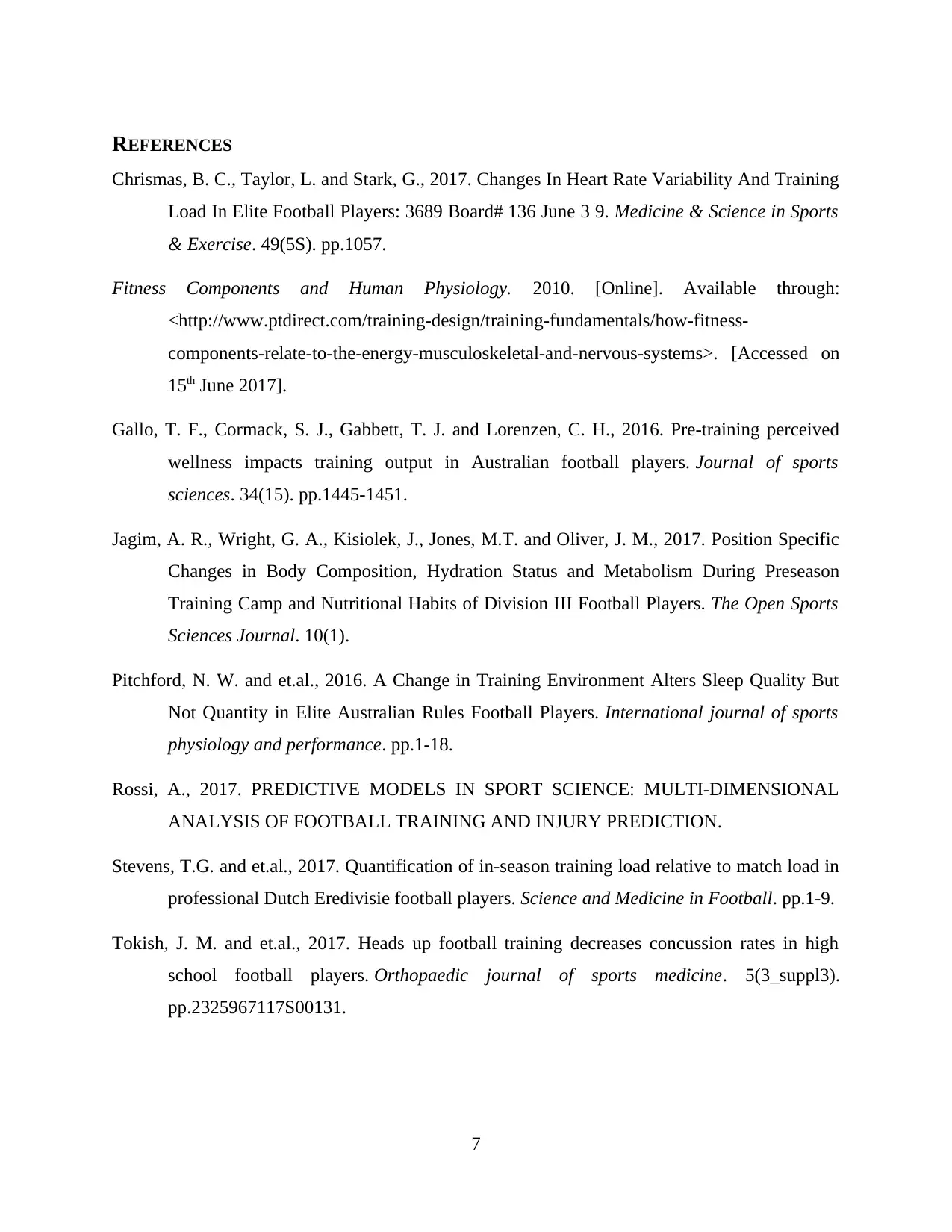
REFERENCES
Chrismas, B. C., Taylor, L. and Stark, G., 2017. Changes In Heart Rate Variability And Training
Load In Elite Football Players: 3689 Board# 136 June 3 9. Medicine & Science in Sports
& Exercise. 49(5S). pp.1057.
Fitness Components and Human Physiology. 2010. [Online]. Available through:
<http://www.ptdirect.com/training-design/training-fundamentals/how-fitness-
components-relate-to-the-energy-musculoskeletal-and-nervous-systems>. [Accessed on
15th June 2017].
Gallo, T. F., Cormack, S. J., Gabbett, T. J. and Lorenzen, C. H., 2016. Pre-training perceived
wellness impacts training output in Australian football players. Journal of sports
sciences. 34(15). pp.1445-1451.
Jagim, A. R., Wright, G. A., Kisiolek, J., Jones, M.T. and Oliver, J. M., 2017. Position Specific
Changes in Body Composition, Hydration Status and Metabolism During Preseason
Training Camp and Nutritional Habits of Division III Football Players. The Open Sports
Sciences Journal. 10(1).
Pitchford, N. W. and et.al., 2016. A Change in Training Environment Alters Sleep Quality But
Not Quantity in Elite Australian Rules Football Players. International journal of sports
physiology and performance. pp.1-18.
Rossi, A., 2017. PREDICTIVE MODELS IN SPORT SCIENCE: MULTI-DIMENSIONAL
ANALYSIS OF FOOTBALL TRAINING AND INJURY PREDICTION.
Stevens, T.G. and et.al., 2017. Quantification of in-season training load relative to match load in
professional Dutch Eredivisie football players. Science and Medicine in Football. pp.1-9.
Tokish, J. M. and et.al., 2017. Heads up football training decreases concussion rates in high
school football players. Orthopaedic journal of sports medicine. 5(3_suppl3).
pp.2325967117S00131.
7
Chrismas, B. C., Taylor, L. and Stark, G., 2017. Changes In Heart Rate Variability And Training
Load In Elite Football Players: 3689 Board# 136 June 3 9. Medicine & Science in Sports
& Exercise. 49(5S). pp.1057.
Fitness Components and Human Physiology. 2010. [Online]. Available through:
<http://www.ptdirect.com/training-design/training-fundamentals/how-fitness-
components-relate-to-the-energy-musculoskeletal-and-nervous-systems>. [Accessed on
15th June 2017].
Gallo, T. F., Cormack, S. J., Gabbett, T. J. and Lorenzen, C. H., 2016. Pre-training perceived
wellness impacts training output in Australian football players. Journal of sports
sciences. 34(15). pp.1445-1451.
Jagim, A. R., Wright, G. A., Kisiolek, J., Jones, M.T. and Oliver, J. M., 2017. Position Specific
Changes in Body Composition, Hydration Status and Metabolism During Preseason
Training Camp and Nutritional Habits of Division III Football Players. The Open Sports
Sciences Journal. 10(1).
Pitchford, N. W. and et.al., 2016. A Change in Training Environment Alters Sleep Quality But
Not Quantity in Elite Australian Rules Football Players. International journal of sports
physiology and performance. pp.1-18.
Rossi, A., 2017. PREDICTIVE MODELS IN SPORT SCIENCE: MULTI-DIMENSIONAL
ANALYSIS OF FOOTBALL TRAINING AND INJURY PREDICTION.
Stevens, T.G. and et.al., 2017. Quantification of in-season training load relative to match load in
professional Dutch Eredivisie football players. Science and Medicine in Football. pp.1-9.
Tokish, J. M. and et.al., 2017. Heads up football training decreases concussion rates in high
school football players. Orthopaedic journal of sports medicine. 5(3_suppl3).
pp.2325967117S00131.
7
Paraphrase This Document
Need a fresh take? Get an instant paraphrase of this document with our AI Paraphraser

Wright, M. D., Hurst, C. and Taylor, J. M., 2016. Contrasting effects of a mixed-methods high-
intensity interval training intervention in girl football players. Journal of sports sciences.
34(19). pp.1808-1815.
8
intensity interval training intervention in girl football players. Journal of sports sciences.
34(19). pp.1808-1815.
8
1 out of 8
Related Documents
Your All-in-One AI-Powered Toolkit for Academic Success.
+13062052269
info@desklib.com
Available 24*7 on WhatsApp / Email
![[object Object]](/_next/static/media/star-bottom.7253800d.svg)
Unlock your academic potential
Copyright © 2020–2025 A2Z Services. All Rights Reserved. Developed and managed by ZUCOL.





